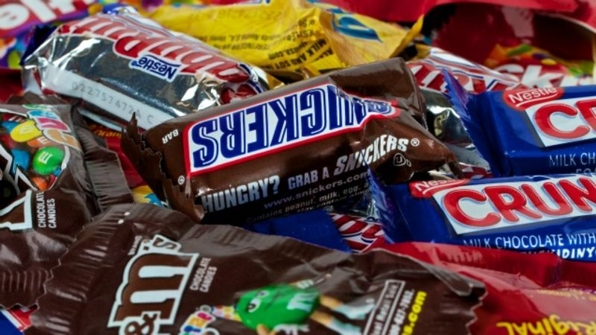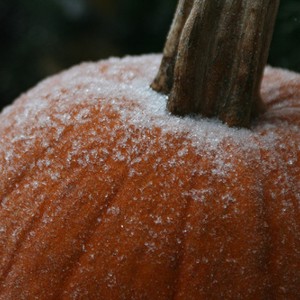Okay. I know that major retail outfits have to plan months or years in advance to make sure they have the right amount of the right kind of stock on hand for major annual sales events. But Hallowe’en isn’t until the end of October, and this is barely the end of July…
 Mini Candy Bars: A traditional Hallowe’en favourite, along with
Mini Candy Bars: A traditional Hallowe’en favourite, along with
all manor of other Sugary Treats and Salty Snacks…
Will this be the last year we see them?
I get it that Hallowe’en is huge for Candy makers and costumers. I also get it that retailers immediately start hyping the next big ‘holiday’ sales period the day after the last one’s gone by. Gone are the days when you could grab great buys on ‘clearance’ candy, specialty food items and entertaining supports such as themes napkins and paper plates for a week or so after a major holiday and put them away for next year.
But geeze! (as my dear, departed Dad would lament.) There’s Hallowe’en stuff in the stores already, and it’s barely the end of July!
And the social media channels are already humming with ‘conversations’ about whether there will even be a Hallowe’en (as we know it) at all this year – what with COVID-19, the recent resurgence in new cases, and the re-imposition of masking and social distancing orders, with no end in sight.
Candy Makers hedging, innovating
Candy makers are saying Hallowe’en will either wither on the vine this year (with questionable odds of ever coming back fully in the image of what most of us remember from our youths, or even a decade or so ago) or transform into something different that still involves monumental sales of their products and the overall themes of ‘shelling out’, ‘trick or treating’, and raucous partying.
In fact, one notable beneficary of the annual Hallowe’en Candy sales explosion, Hershey’s, says it expects overall sales of its confections to be down by as much as 10 percent, compared to last year, for the fiscal quarter in which the spooky holiday falls. This in spite of unexpected but gratifying increases in overall demand for Candy and Confectionary products – along with Salty Snacks, Baked Goods, Heat-and-Eat products and other Junk food Staples. Nevertheless, Hershey’s (and probably the other companies that customarily ramp-up specialty production for Hallowe’en) are pulling back on that focus because they don’t want to risk getting stuck with mountains of product they’ll have to either sell off at a loss or dispose of after a ‘bust’ Hallowe’en season.
Industry watchers and psychologists attribute that overall increase to the COVID-19 stay-home social isolating culture, which features increased screen time snacking, ‘consolation’ and ‘comfort’ snacking, and an increasing tendency to settle for convenience foods rather than the kind of stuff we used to eat when life was built around more-rigid routines, which themselves were built around work, school and other ‘organized’ activities that have gone by the wayside during the pandemic crisis.
The new normal?
The crystal ball readers say traditional trick and treating may evolve into something more closely resembling a football-season tailgating party, where folks who want to participate will come to a central point – say, a community centre or school parking lot – and dispense candy and spooky surprises from the trunks or tailgates of their vehicles, keeping contact time for all involved to a minimum while still observing the spirit and tradition of the season. Social distancing protocols and masking rules will, of course, be followed as if it was a trip to a restaurant.
But, remember: this is what the folks who have the most to lose are predicting. This ‘troll-gating’ scenario would work to their best advantage, maintaining something more like ‘normal’ Candy and costume sales in the face of the pandemic. And there is something to be said about this vision’s resemblance to already evolving ‘traditions’ surrounding the childrens’ Hallowe’en experience involving collective, ‘safe’, community-organized events.
My take
First and foremost, I want to stress that, as invisible as some of the other impacts of a curtailed or cancelled Hallowe’en may be to the average person, they are of fundamental importance to the folks who usually cater office and house parties. Here comes another lost ‘season’ for them. And what about the people who grow all those Pumpkins? Did they put in a crop as usual, betting that the pandemic would be over by the end of October? Or have they opted to grow something else they can sell to local grocers and the public (at roadside stands) to make up for the losses they stand to incur as a result of a lost Hallowe’en?
I agree that anything which makes Hallowe’en safer for our children is a good thing. And I kind of wonder if we, as a culture, haven’t outgrown the need for a mid-fall opportunity to blow off the steam built up over what is arguably the most pressurized season of the year? One correspondent of mine has already suggested that Hallowe’en should be set aside in favour of a new ‘holiday’ that marks the unofficial end of the Grilling Season, incorporating a final tribute to the outdoor culture we call ‘Summer’, with the ceremonial shrouding of the Grill, and the shifting into storage of the cushions for the patio furniture until next Spring.
The question is, how are you planning to ‘do’ Hallowe’en this year? Maybe it’s not too early, after all, to begin thinking and planning…
~ Maggie J.

